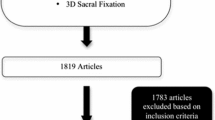Abstract
Purpose
Traditional fluoroscopic techniques during percutaneous fixation of the posterior pelvic ring at times cannot adequately visualize errant or malpositioned iliosacral screws. Intra-operative fluoroscopic techniques have been advanced using multi-dimensional fluoroscopy to generate computed tomography-like images. This provides the surgeon not only the ability to assess iliosacral screw placement, but also the opportunity to assess reduction. We present a case series of four patients in which the Ziehm RFD multi-dimensional fluoroscopy was used to assess reduction and guidepin placement prior to definitive iliosacral screw fixation.
Methods
Four patients at our university level 1 trauma center with posterior pelvic ring disruptions were treated with percutaneous iliosacral screw fixation. Traditional fluoroscopic techniques were used during guidepin placement. Multi-dimensional fluoroscopy was performed using the Ziehm RFD 3D to assess guidepin placement and reduction prior to definitive iliosacral screw fixation.
Results
Our case series highlights two patients in which multi-dimensional fluoroscopy was utilized to ensure safe placement of iliosacral screws. In one of these two patients, a change was made after reviewing the imaging as a guidepin was found to be intruded into bilateral S2 neural tunnels. We also present two patient examples in which multidimensional fluoroscopy was used to assess reduction achieved by less invasive methods, precluding the need for direct visualization using more extensive open approaches.
Conclusions
This retrospective case series demonstrates the direct impact that the Ziehm RFD 3D technology provides in surgical management of patients with complex posterior pelvic ring injuries.




Similar content being viewed by others
References
Routt ML Jr, Simonian PT, Mills WJ (1997) Iliosacral screw fixation: early complications of the percutaneous technique. J Orthop Trauma 11(8):584–589
Gardner MJ, Farrell ED, Nork SE, Segina DN, Routt ML Jr (2009) Percutaneous placement of iliosacral screws without electrodiagnostic monitoring. J Trauma 66(5):1411–1415. doi:10.1097/TA.0b013e31818080e9
Herman A, Keener E, Dubose C, Lowe JA (2016) Simple mathematical model of sacroiliac screws safe-zone-easy to implement by pelvic inlet and outlet views. J Orthop Res. doi:10.1002/jor.23396
Lindsay A, Tornetta P 3rd, Diwan A, Templeman D (2016) Is closed reduction and percutaneous fixation of unstable posterior ring injuries as accurate as open reduction and internal fixation? J Orthop Trauma 30(1):29–33. doi:10.1097/BOT.0000000000000418
Conflitti JM, Graves ML, Chip Routt ML Jr (2010) Radiographic quantification and analysis of dysmorphic upper sacral osseous anatomy and associated iliosacral screw insertions. J Orthop Trauma 24(10):630–636. doi:10.1097/BOT.0b013e3181dc50cd
Gardner MJ, Morshed S, Nork SE, Ricci WM, Chip Routt ML Jr (2010) Quantification of the upper and second sacral segment safe zones in normal and dysmorphic sacra. J Orthop Trauma 24(10):622–629. doi:10.1097/BOT.0b013e3181cf0404
Zwingmann J, Hauschild O, Bode G, Sudkamp NP, Schmal H (2013) Malposition and revision rates of different imaging modalities for percutaneous iliosacral screw fixation following pelvic fractures: a systematic review and meta-analysis. Arch Orthop Trauma Surg 133(9):1257–1265. doi:10.1007/s00402-013-1788-4
Takao M, Nishii T, Sakai T, Yoshikawa H, Sugano N (2014) Iliosacral screw insertion using CT-3D-fluoroscopy matching navigation. Injury 45(6):988–994. doi:10.1016/j.injury.2014.01.015
Stockle U, Schaser K, Konig B (2007) Image guidance in pelvic and acetabular surgery—expectations, success and limitations. Injury 38(4):450–462. doi:10.1016/j.injury.2007.01.024
Theologis AA, Burch S, Pekmezci M (2016) Placement of iliosacral screws using 3D image-guided (O-Arm) technology and Stealth Navigation: comparison with traditional fluoroscopy. Bone Joint J 98-B(5):696–702. doi:10.1302/0301-620X.98B5.36287
Zwingmann J, Konrad G, Kotter E, Sudkamp NP, Oberst M (2009) Computer-navigated iliosacral screw insertion reduces malposition rate and radiation exposure. Clin Orthop Relat Res 467(7):1833–1838. doi:10.1007/s11999-008-0632-6
Miller AN, Routt ML Jr (2012) Variations in sacral morphology and implications for iliosacral screw fixation. J Am Acad Orthop Surg 20(1):8–16. doi:10.5435/JAAOS-20-01-008
Letournel E, Judet R (1993) Fractures of the acetabulum, 2nd edn. Springer, New York
Mears D, Rubash H (1983) Extensile exposure of the pelvis. Contemp Orthop 6(2):21–31
Reinert CM, Bosse M, Poka A, Schacherer T, Brumback R, Burgess A (1988) A modified extensile exposure for the treatment of complex or malunited acetabular fractures. J Bone Joint Surg Am 70(3):329–337
Author information
Authors and Affiliations
Corresponding author
Ethics declarations
Sources of support
No outside funds were received in support of this work.
Conflict of interest
Drs. Routt and Gary have previously given one-time compensated presentations regarding this technology for Ziehm and are not consultants for Ziehm. Dr. Shaw has no conflicts of interest regarding this manuscript.
Rights and permissions
About this article
Cite this article
Shaw, J.C., Routt, M.L.“. & Gary, J.L. Intra-operative multi-dimensional fluoroscopy of guidepin placement prior to iliosacral screw fixation for posterior pelvic ring injuries and sacroiliac dislocation: an early case series. International Orthopaedics (SICOT) 41, 2171–2177 (2017). https://doi.org/10.1007/s00264-017-3447-9
Received:
Accepted:
Published:
Issue Date:
DOI: https://doi.org/10.1007/s00264-017-3447-9




